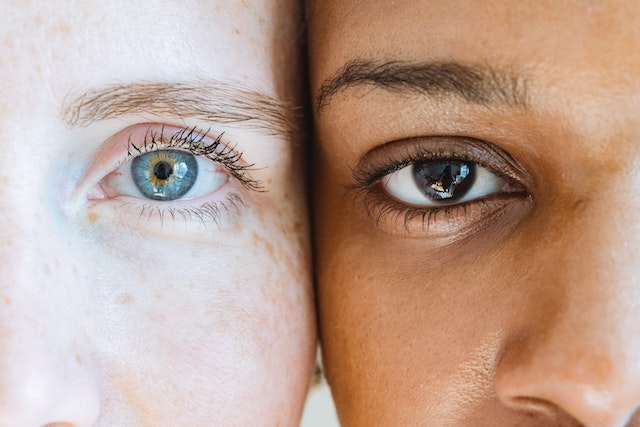Browsing on Amazon, scrolling on Instagram, swiping left and right on Tinder, observing people at an airport, and talking with others all have one common feature – we are judging looks, consciously and unconsciously. Visual awareness, which is raw data entering the eyes with the brain’s influence[1], affects our thoughts, emotions, behavior, and decisions. Our visual system extracts vital information from the environment, so how things look matters at a fundamental level.
Why looks matter: we pay attention to visuals first and remember them better, and then use those to make judgments because that's easy. Manipulating an object or person's looks can improve judgments about trust, quality, and skill. Share on X12 ways looks influence first impressions and our judgments
- 1. We think beautiful is good and ugly is bad, and we pay a beauty premium
- 2. We impose an ugliness and plainness penalty
- 3. The very existence of a face matters
- 4. We judge the best musicians on looks even when the sound seems most important
- 5. Beautiful people are more likely to get a people-facing job in the hospitality industry
- 6. Looks based on thumbnails and previews matter a lot while browsing YouTube and OTTs
- 7. Looks affect whether we trust a website or not before even reading the content
- 8. We are biased toward cute and smart animals
- 9. Font appearance affects the purpose of writing
- 10. Your smile or frown tells others if they should approach or avoid you
- 11. It’s not what it looks like – looking suspicious even when not guilty lowers trust
- 12. Food appearance literally affects our taste and expectations
- Why looks matter: we pay attention to visuals first and remember them better, and then use those to make judgments because that’s easy
- Sources
We associate beauty with good and ugly/plain with bad, wait longer for things we like[3], and even give extra advantages like more money and leeway to beautiful people[4] and beautiful tech[5] (called paying a beauty premium). Similarly, we give a disadvantage to unattractive people and ugly products. We also put more mental effort to stop thinking and saying, “ugly is bad[6].” The beauty stereotype says we judge attractive people to have favorable personality qualities like warmth, skill, trust, etc., and incorrectly consider unattractive people less intelligent, social, and helpful[7]. We use their beauty to judge their skills, intelligence, social abilities, and morality. Children also show this beauty stereotype[8]. They think attractive people are more agreeable (kind, trustworthy, cooperative, warm), less neurotic (less anxious and not prone to negative thoughts), open to experience (willing to explore and learn), extroverted (socially energetic), and conscientious (disciplined, detail-oriented).
2. We impose an ugliness and plainness penalty
Just like we overvalue beautiful things/people (beauty premium), we undervalue plain or ugly things/people (plainness or ugliness penalty). We buy less from plain-looking sellers[9], and both attractive and unattractive people[10] tend to earn more than the average-looking person. When it comes to sales and salaries, standing out might help. Even for organic produce, we impose a plainness or ugliness penalty[11] – we are willing to pay less for unattractive products, mainly because they don’t make us feel good. Similarly, there is an ugliness penalty on donations and being generous[12] – we tend to be more generous toward the more attractive donees than the more needy donees instinctively. Overall, this reflects our tendency to help the beautiful before the needy. But this reverses with deliberate thought.
3. The very existence of a face matters
Between all objects and faces, the brain tends to spot faces first[13]. Research suggests we process the face shape and feel it is there even when we aren’t aware of that face. We also process a genuine face faster than a fake face. The brain is flexible in seeing faces when they aren’t actually there (called pareidolia) because it can tolerate variations in local features like eye distance, nose shape, chin, etc. But it processes the combination of contours + location of eye-like and mouth-like objects together as a face template. Giving a face to something is, therefore, very important. While it feels personal to interact with a human, it is mainly prioritized information via facial features.
We form first impressions about personality[14] just from looks within 39 milliseconds with more emphasis on survival-related qualities like help, threat, care, health, etc. than emotions or intelligence. Combining these 2 insights – we get ideas like cars, with their lights, hoods, mirrors, etc., have faces with personalities. Here’s the other reason we give personalities to things.

4. We judge the best musicians on looks even when the sound seems most important
In a study where people had to choose winners of a live music show[16], those who saw only short silent video clips of them playing were able to accurately predict the winners. Their accuracy was around 50% for video-only clips (33% expected by chance) and 25% for sound-only clips. Even when sound is music’s main feature, people judged the sound based on how the musicians look live. Moreover, novice and pro musicians were both unable to pick the winners based on audio or audio + video recordings. This may happen because we unconsciously give high importance to visual information to process confidence, musical cohesion, and other body language features. Having more critical information, like the sound in a music show, might actually interfere with our judgments. The study suggests we lack confidence in snap judgments, but they often tend to be true.
5. Beautiful people are more likely to get a people-facing job in the hospitality industry
In a study that sent fake resumes to many hospitality job openings in Taiwan[17], researchers saw that resumes with more attractive photos got more callbacks for an interview. According to their data, looks matter most for front desk jobs and a little less for restaurant serving jobs but don’t matter for housekeeping jobs, management training, and kitchen staff. The looks advantage was higher for male resumes than female resumes. With the risk of overgeneralization, women may be more skilled[18] at handling hospitality jobs, so there may be a bias to hire them less selectively than men.
6. Looks based on thumbnails and previews matter a lot while browsing YouTube and OTTs
One study used real-life user behavior data to assess which videos[19] get popular. They found that people watch videos based on basic judgment shortcuts (heuristics) like current views, the thumbnail, and previews. These details reduce the “quality uncertainty,” which is the general lack of knowledge about the quality of content. Seeing hints of quality helps us decide whether we should risk watching a video or not. People tend to look at the thumbnails first[20] and give almost twice the amount of attention to thumbnails compared to titles while browsing videos.
7. Looks affect whether we trust a website or not before even reading the content
Generally, visually appealing websites are trusted most. People have a gut feeling if a site is trustworthy or not based on simple signals like design familiarity, design’s emotional impact, availability of authority information, ease of use, face validity (whether the site looks legit or not), brand value, social details, and security/authenticity markers. Website trust develops through[21] easy-to-judge design features that form the look of a website. These are – appealing graphics, easy and intuitive structure, human faces, social media links and details, interactive elements like chat assistance, affiliated brands, quality information, and security policy/seals.
People judge credibility from superficial features[22] for health information. A boring or overly complex design reduces trust, but quick visual details like the presence of FAQs, author details, author and owner credibility, a good logo, testimonials, references, and pictures quickly raise trust.
Looks matter because the brain prioritizes visual information. Here are some ways in which looks matter and give us extra information beyond visual input. Share on X8. We are biased toward cute and smart animals
Studies looking at how humans judge animals[23] have repeatedly shown that good-looking animals, non-food animals, and those with human-like qualities get more compassion from us. People are willing to ascribe more morality and intelligence and even put in more effort to protect them than, say, insects that don’t have human-like traits. Except bees, everyone loves bees.

9. Font appearance affects the purpose of writing
Research on how fonts affect our brain’s processing and attention shows that the biggest visual element of written content has a dramatic effect on how we interact with it. Fonts like Times New Roman enhance satire better than other fonts like Arial. Another example is how hard-to-read fonts can make it easier to concentrate in a noisy environment. This happens because the extra effort needed to read difficult fonts captures our attention and shields us from distractions because there is less mental bandwidth for the mind to get distracted. Slightly harder-to-read fonts are also better for memory and comprehension, and pretty fonts might inspire creative thinking. So if you are a designer or baker, good-looking fonts might help your potential clients think creatively while looking at your website. Similarly, if you are an educator, difficult fonts might help students learn better.
10. Your smile or frown tells others if they should approach or avoid you
If you think smiling makes people look good and think they are nice, you’re right[24]. Smiling makes people look attractive and also lead others to believe they are sincere, less masculine, and skilled, but also less independent (so more approachable and social). Smiling is a wealth of important social information. Anger, threat, or aggression, on the other hand, is the easiest to spot[25] (the anger superiority effect), and triggers us to avoid related threat. Any form of hostility by any brand, person, or object is likely to motivate us to avoid it.
In a study that processed raw visual data of human faces[26], researchers saw that people usually want to approach a smiling face and avoid a frowning face without actually judging and perceiving their qualities – mere looks determine if you are approachable or avoidable. Generally, an approachable person has a smiling face and is assigned qualities like intelligence, attractiveness, trustworthiness, caring, emotionally stable, responsible, social, and confident – all good first impressions. Whereas an avoidable person has a frown and is assigned negative qualities like aggression, meanness, unhappy, boring, weird, and egotistic – all bad impressions. Some of these judgments can occur extremely fast as people can correctly judge if you are an extrovert or not within 50 seconds[27].
11. It’s not what it looks like – looking suspicious even when not guilty lowers trust
Researchers assessed how a threatening background context affects people’s trustworthiness[28] in 2 ways: it looks like the human did something or it looks unrelated to the human. Not surprisingly, when negative actions look like they caused a negative situation, we lose trust. We often judge a person negatively in an ambiguous context, like assuming they stole if they are present at a robbery. We reduce that ambiguity by making a story that makes sense. If it makes sense and feels possible, we find them less trustworthy. Knowing if someone is a victim or perpetrator affects trust too. Researchers found people tend to assume the worst first. When there is a threatening context, we lose trust just as much as knowing they did wrong. We assume the negative as if it’s a fact. However, we don’t lose trust when they are a victim. Another study[29] shows police and laypeople are worse at detecting a suspect’s lies if they are handcuffed than when they are without cuffs. A possible reason is that the negative image of seeing a suspect in handcuffs overpowers other information like body language, which could’ve helped with more accurate lie detection.
These findings imply something negative but common – we have a suspicious mindset, and our snap judgments are as if people are at fault.
12. Food appearance literally affects our taste and expectations
One sense affects the other, and this is particularly important for food. We expect spicy food to look red or green, and if it isn’t, we don’t feel it is as spicy as it should’ve been. Even motion in food like dripping cheese or the fizz of soda makes it more appealing. Rounder sweets taste sweeter than square sweets. And, sweets served on a round plate also appear sweeter than those put on a square plate. Even for coffee, narrow mugs seem to make coffee more aromatic. There is a general trend in visual elements of food and drinks: spiky or angular shapes make food spicy, crunchy, and salty, while curvy and round shapes make them sweet and soft. Sometimes, the visuals only affect our expectations and not the actual taste.
Why looks matter: we pay attention to visuals first and remember them better, and then use those to make judgments because that’s easy
In psychology, there is “visual precedence,” “halo effect,” and “the picture superiority effect,” which loosely say looks matter in all areas where visual information is available. Specifically, our judgments are based more on visual information than other information.
Visual precedence is when the brain prioritizes visual information and processes it deeper than other information. So when the brain relies on visual data coming from the eyes, it uses that data to influence a large chunk of our final thoughts, decisions, emotions, and behavior. Pre-existing emotions and existing knowledge also affect visual precedence because emotions influence where we pay attention, and knowledge affects our expectations of what we see. For example, a negative mood makes it easier to spot negative details, but a positive mood makes it easier to spot positive details. Similarly, experience in spotting errors while typing makes it easier to expect certain typos that you are prone to. The important point here is that emotions and experience guide our attention to look for visual details in many cases.
The halo effect also occurs – if it looks good, it must have other good qualities. This is a decision-making shortcut – a heuristic called “attribute substitution.” We unconsciously simplify our decision-making by using easy-to-access information as a substitute for hard-to-access information. It is an overgeneralization – we use looks to generalize other characteristics because looks are easy to access, and the rest isn’t. This is called the beauty stereotype in the context of people and objects. If you notice something is beautiful, it affects your overall or specific judgment about that thing. For example, if you see a beautiful car, you might think it’s an overall good car. If you meet a good-looking person, you’d probably judge they are nice, smart, and caring. You may also think a beautiful hotel might serve good food (which it might not).
The picture superiority effect says we tend to remember visual details better than non-visual details. The brain itself is a visual learner. We are more likely to remember 10 random pictures than 10 random words, and we are more likely to remember objects if they are shown as pictures one by one instead of reading a list or hearing someone list them. Visual details provide more conceptual information[30], and signals through the eye are richer. Information conveyed from the eyes generally also activates associated words. So seeing a helicopter also triggers the word helicopter in mind, leading to strong first impressions. Whereas hearing the word helicopter doesn’t necessarily bring the picture into mind. The Dual Coding theory[31] says visual data activates its verbal layer more strongly[32] than verbal data activates its visual layer, so visual details influence us strongly and create stronger, richer memories – in short, visuals create lasting impressions.
Human brains have a lot of visual data processing power[33], with 45 times more neurons[34] in the primary visual cortex than the primary auditory cortex. Plus, visual neurons do more than just see, they make decisions and think[35] and use information[36] from all other senses. The broad explanation for why looks matter so much is that certain appearances benefited us through evolution, like certain body types, fruit colors, looking sick/healthy or aggressive/approachable, etc. When they helped us survive, they became attractive in the literal sense – we started preferring them because they were rewarding. Then randomly mutated genes that automatically helped spot the preferences, pass judgment, and behave according to those preferences gave a brain biased toward looks. Concepts like aesthetics and beauty are likely evolutions of basic preferences.
Sources
[2]: https://www.pexels.com/photo/diverse-women-looking-at-camera-7480009/
[3]: https://psycnet.apa.org/buy/2020-84182-001
[4]: https://www.aeaweb.org/articles?id=10.1257/000282806776157515
[5]: https://www.sciencedirect.com/science/article/abs/pii/S0969698921004380
[6]: https://www.sciencedirect.com/science/article/abs/pii/S0028393221000750
[7]: https://www.ncbi.nlm.nih.gov/pmc/articles/PMC1447532/
[8]: https://www.acrwebsite.org/volumes/v49/acr_vol49_3000048.pdf
[9]: https://journals.sagepub.com/doi/abs/10.1177/0022242920914861
[10]: https://link.springer.com/article/10.1007/s10869-017-9489-6?ftag=MSFd61514f
[11]: https://journals.sagepub.com/doi/full/10.1177/0022242918816319
[12]: https://journals.sagepub.com/doi/full/10.1509/jmr.14.0658
[13]: https://psycnet.apa.org/record/2021-44292-001
[14]: https://psycnet.apa.org/record/2006-07383-010
[15]: https://www.pexels.com/photo/photo-of-red-car-during-dawn-3758443/
[16]: https://www.pnas.org/doi/full/10.1073/pnas.1221454110
[17]: https://www.sciencedirect.com/science/article/abs/pii/S0278431916301475
[18]: https://www.researchgate.net/publication/336200584_Do_Women_Make_Better_in_Tourism_and_Hospitality_A_Conceptual_Review_from_A_Customer_Satisfaction_and_Service_Quality_Perspective#:~:text=The%20analysis%20of%20multidisciplinary%20research,entrepreneurship%20in%20tourism%20and%20hospitality.
[19]: https://onlinelibrary.wiley.com/doi/abs/10.1002/asi.21641
[20]: https://dl.acm.org/doi/abs/10.1145/3204493.3204571
[21]: https://www.researchgate.net/publication/237006618_The_Effect_of_Website_Design_Dimensions_on_Initial_Trust_A_Synthesis_of_the_Empirical_Literature
[22]: https://www.jmir.org/2017/6/e218/
[23]: https://www.sciencedirect.com/science/article/abs/pii/S0272494421000773
[24]: https://onlinelibrary.wiley.com/doi/abs/10.1002/ejsp.2420200307
[25]: https://jov.arvojournals.org/article.aspx?articleid=2738015
[26]: https://www.sciencedirect.com/science/article/abs/pii/S0010028521000104
[27]: https://www.sciencedirect.com/science/article/abs/pii/S0092656609000804?via%3Dihub
[28]: https://journals.sagepub.com/doi/10.1177/01461672211065933
[29]: https://onlinelibrary.wiley.com/doi/full/10.1002/jip.1597
[30]: https://www.tandfonline.com/doi/abs/10.1080/09541440500412361
[31]: https://link.springer.com/article/10.1007/BF01320076
[32]: https://www.proquest.com/openview/eb712722d82a578501a8acf5ca234024/1?pq-origsite=gscholar&cbl=41758
[33]: https://pubmed.ncbi.nlm.nih.gov/29494110/
[34]: https://www.ncbi.nlm.nih.gov/pmc/articles/PMC3727908/
[35]: https://pure.knaw.nl/ws/files/2702020/Roelfsema2016AnnRevVisSci.pdf
[36]: https://www.hindawi.com/journals/np/2018/5380921/

Hey! Thank you for reading; hope you enjoyed the article. I run Cognition Today to capture some of the most fascinating mechanisms that guide our lives. My content here is referenced and featured in NY Times, Forbes, CNET, and Entrepreneur, and many other books & research papers.
I’m am a psychology SME consultant in EdTech with a focus on AI cognition and Behavioral Engineering. I’m affiliated to myelin, an EdTech company in India as well.
I’ve studied at NIMHANS Bangalore (positive psychology), Savitribai Phule Pune University (clinical psychology), Fergusson College (BA psych), and affiliated with IIM Ahmedabad (marketing psychology). I’m currently studying Korean at Seoul National University.
I’m based in Pune, India but living in Seoul, S. Korea. Love Sci-fi, horror media; Love rock, metal, synthwave, and K-pop music; can’t whistle; can play 2 guitars at a time.




























